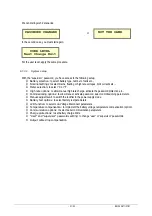
BN 09 2671/01/01
- 44 / 50 -
9 PARALLEL OPERATION
The Protect RCS rectifier charger can operate also as parallel system. The following configuration are available:
System
:
Redundant
- for a charger and/or battery redundancy.
Parallel
- to increase the power or to increase the battery capacity.
Battery
:
Common
the chargers in parallel are connected to a common bus on which a single battery is connected.
Depending on the configuration the different options can be used in the system. The output blocking diode is
mandatory for this operation mode.
9.1 REDUNDANT SYSTEM CONFIGURATION
The purpose of a redundant system is to obtain maximum availability of the load supply, including any fault of the
battery chargers. The redundant configuration facilitates also the on-site maintenance operation.
In a redundant system, the aim is to limit the “common mode failures” between the 2 chargers: avoid anything that
could lead to the spread of a fault, of a process or a component failure, of a power source failure (charger, battery
etc.) to another, in order to ensure permanent supply of the load.
The “decoupling” method chosen in the Protect RCS is the most reliable one.
9.2 PARALLEL SYSTEM CONFIGURATION
The paralleling of the systems in not redundant configuration is used to increase of the power of the chargers.
The paralleling of the systems is used also for increasing the battery capacity when the direct paralleling of the
battery strings is not authorised (e.g.: VO battery). In this case, the management of each battery string is
independent. This topology system ensures optimum management of each battery string in terms of availability
(recharging), monitoring and ageing.
9.3 OPTIONS FOR PARALLEL SYSTEM
CONFIGURATIONS
The options described below are used depending on the system configuration
9.3.1 Passive Load sharing
(“droop” factor) function
The option is a function of the GCAU control bard. It is used when two rectifiers are connected in the parallel
configuration and load sharing is required.
The load sharing is passive and is based upon changing the slope (“droop” factor parameter) of the rectifier output
voltage according to its output current. The droop factor reduces the output voltage if the system current rises.
The on-site installation must as far as possible minimize connection or installation dissymmetry (thermal conditions,
lengths and wire sections, protections etc.) of the chargers towards the batteries and the load.







































